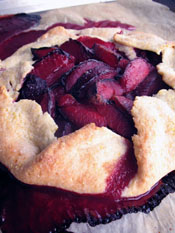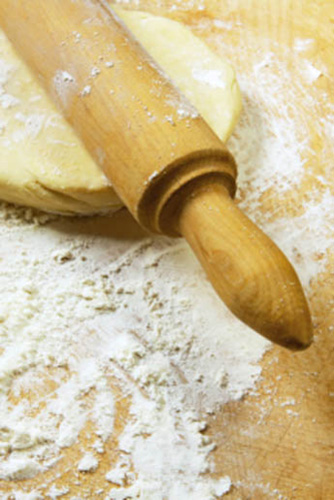Making Pies and Tarts
I taught myself how to bake pies. Even though my mother was an excellent pie baker, she limited herself to apple and pumpkin pies at Thanksgiving and chocolate cream for family birthdays. I had bigger ambitions.
The first pie I made had a store-bought frozen crust that I filled with a mixture of melted vanilla ice cream and lemon Jello that took on the texture of a creamy chiffon. At the time I thought this was the best pie I had ever tasted. Would I make it again? I don't think so.
My pies got better. I advanced to buying a small metal rolling pin and sticks of pie "dough" that I'm sure were some combo of gums and trans fats. Anyway, you'd break these sticks of dough into a mixing bowl, add water and with a fork, get the water absorbed as the texture of the dough softened enough to be rolled out and placed in a pie plate and baked empty. Once cooled, I'd fill the crust with chocolate or vanilla pudding made from a mix and topped it all with whipped cream and maybe some sliced bananas.
Soon I became fixated on making my own piecrusts. After studying The Joy of Cooking and New York Times Cookbook, I bought a hefty wood rolling pin, a pastry blender, and a bag of flour and decided to make a pumpkin pie -- completely from scratch. Although it was decades ago, I clearly remember becoming so angry at my failure to get the pie dough to come together that I balled up the gloppy dough and tossed it against my kitchen wall. I took a walk. I smoked a couple of cigarettes (hey, this was a long time ago). And I returned home to start again, although first I had to scrape the remnants of my pie dough off the wall where it had stuck while I had walked around the block.
Looking back, I was making progress. And with the quality of the pies I make today, I am so glad I did not give up. I am humble about most things I've learned to do in life but when it comes to my pies, I have pride. They are damn good. And having mastered something that many superb home cooks still find intimidating, I want to give you some encouragement and basic wisdom about making pies in small city kitchens.
Making Pie Dough
I've tried scores of methods and recipes. I've done the dough entirely by hand. I've done them with all butter, all lard, all Crisco. I've made versions with vinegar and with oil. I've made dough completely in the Cuisinart. I've mixed the ingredients in the pie plate, on a cold marble slab, and in a bowl. And here are some things I know for sure about pie:
- The dough is essential to the pie's flavor. It's not just about the filling. And the taste of the dough will only be as good as the ingredients you use. So use good unsalted butter, Crisco with no transfats, or organic leaf lard. I've been told, and this makes sense to me, that fats melt at different temperatures and it's the melting of the fat that gives piecrust its flakiness. To my palate, the best dough comes from a combination of butter (for flavor) and Crisco or leaf lard for flakiness.
- What is leaf lard? It's rendered pork fat and is considered the best grade of lard. Pure white, it has no discernable pork flavor (no, your pies won't taste like bacon). I buy my leaf lard from the great people at Flying Pigs Farm at their Greenmarket stand either in Park Slope or Union Square. They also sell it on their web site. The quality is remarkable and the lard will stay stable in your freezer forever. Just don't try to buy it the weekend before a big holiday like Thanksgiving because they sell out early.
- In an entirely different direction is dough made with oil. Pie crusts made with vegetable oil have been winning awards at state fair competitions for generations. The theory is that oil replaced butter during war years and the Depression, when butter was either scarce or just too costly. But there are other reasons for oil-based crusts and the biggest is diet -- some of us just can't or won't eat foods made with butter. A recent posting at "Chocolate & Zucchini," Clotilde Dusoulier's blog, featured a recipe for "Easy Olive Oil Tart Crust." We've added a link.
- The biggest threat to making pie dough is heat. If it's midsummer and you want to make a peach pie, you either have to crank up the air conditioning or get up early before the heat of the day because making pie dough on a hot afternoon will result in a tough crust. That's because flaky crust is the result of little bits of fat (the butter or lard) that remain intact until the dough hits the hot oven. The fat melts, leaving tiny pockets of air that become the flaky layers.
- Keep the work surface cool to cold, the water icy and your hands cold (I sometimes stop mid-dough-making and run my hands under ice cold water to chill them down).
- The best method I've found for making the dough is from Cook's Illustrated/Best Recipes. The flour and fats are combined in the food processor and the water is added by hand. This way the fats are handled as little as possible (see above point) and you still can control the volume and pace of adding the water. We've added our adaptation of the recipe and method.
- Just when you think you've got a dough recipe nailed, one day it will surprise you. That's because the temperature and humidity of the day can have a huge impact on your result, another reason to start the dough in the food processor but finish it by hand. One day your dough will take 4 tablespoons of ice water; another day it will be six. So learn to know what a good dough feels like and this will guide you better than a recipe.
- Invest in a decent rolling pin. The weight and size of the pin will do most of the work, helping to limit the amount of handling of the dough. Plus use your rolling pin to move your dough around -- roll it onto the pin and spin it onto a pie plate filled with fruit.
- For the best and most satisfying pies, work with what's in season. That means making apple pie in the fall, pecan or chocolate cream in the winter, and fruit pies all summer long. We've added our recipe for a Classic Peach Pie.
- The most important lesson I've learned is that pie dough is resilient. If you add too much water, don't worry. Add a bit more flour and it will be restored. Too crumbly? Add more water. If you're rolling out the dough and it tears, just patch it or pull the whole ball of dough back together and roll it out again. Try your best to handle the dough as little as you can and keep your hands cool. But the dough isn't really fragile.
Pies, Tarts and Galettes
If you want variety or are still feeling clumsy when rolling out and constructing an actual pie, there are easier alternatives:
Galettes. Roll out a circle of dough. Fill it with sugared fruit. Fold up the edges into a rustic tart that has an opening in the center. Use a spatula to transfer the tart onto a piece of parchment paper and place it on a rimmed sheet pan (the fruit juices may leak) and bake like a pie. We have a recipe for a Plum Galette that explains the process in more detail.
Turnovers. Roll out the dough and cut it into 4-inch squares. Place a spoonful of sugared fruit or preserves or bits of semi-sweet chocolate into the center, leaving about an inch border. Fold the dough over so to create a triangle shape. Bake like a pie until the crust is golden.
Tarts. Use a fluted tart pan with a removable bottom. Line the pan with the dough. If the dough breaks don't worry because you can add the dough in pieces and just press together at any seams or breaks. Fill the pan with thin slices of apples or other fruit and bake. Or you can pre-bake the empty pastry tart until it is golden brown and crispy. When it's completely cooled, fill it with fresh fruit and whipped cream. Tarts can be more flexible and easier to construct than pies simply because there's no top crust to deal with.
Overall, my best advice is to just practice. Pie is primarily about assembly. And since we're talking about flour and butter and Crisco, if for some reason your dough fails, just toss it away and start again. With every pie you'll get better until one day, you won't even think about your technique. However, I strongly recommend you do not throw it against the wall of your kitchen. I never did get that stain completely washed off.

